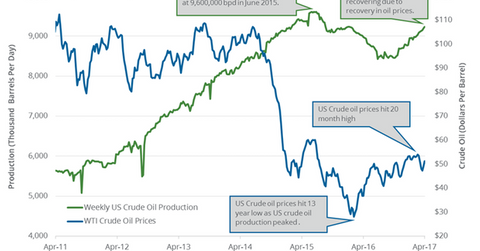EIA Raises Estimates for US Crude Oil Production in 2018
The EIA (U.S. Energy Information Administration) reported that US crude oil production rose by 36,000 bpd (barrels per day) to 9,235,000 bpd between March 31 and April 7, 2017.
Nov. 20 2020, Updated 12:48 p.m. ET

US crude oil production
The EIA (U.S. Energy Information Administration) reported that US crude oil production rose by 36,000 bpd (barrels per day) to 9,235,000 bpd between March 31 and April 7, 2017. Production rose 0.4% week-over-week and 2.9% year-over-year. US crude oil production is at its highest level since January 15, 2016. The rise in US crude oil production is the biggest bearish driver for crude oil (XLE) (DIG) (USO) (PXI) prices in 2017.
Lower crude oil prices have a negative impact on the earnings of oil and gas producers like Devon Energy (DVN), QEP Resources (QEP), Goodrich Petroleum (GDP), and Continental Resources (CLR). For more on crude oil prices, read part one of this series.
Peaks and lows
US crude oil production peaked at 9,600,000 bpd in June 2015. In contrast, it hit a low of 8,428,000 bpd for the week ending July 1, 2016, the lowest level since June 2014. Since then, US crude oil production has risen ~9.6%.
US crude oil production estimates 
The EIA released its Short-Term Energy Outlook (or STEO) report on April 11, 2017. It estimates that US crude oil production will average 9,220,000 bpd in 2017, which is 0.1% higher than the previous estimates. The EIA also estimates that production will average 9,900,000 bpd in 2018, which is 1.8% higher than the previous estimates. US production will likely hit a 48-year high in 2018. US crude oil production averaged 8,880,000 bpd in 2016.
US production could rise in 2017 due to the following factors:
- technological advances that are leading to a rise in US drilling activity even at lower crude oil prices
- higher crude oil prices in 2017 compared to 2016
- implementation of President Trump’s proposed energy policies
The rise in production could pressure US crude oil (UCO) (IEZ) prices. The US might be the main producer to offset the fall in the crude oil supply from major oil producers’ output cut deal.
Tyche Capital Advisors thinks that if US production rose at the current pace, it would offset the reduction in supply from the major oil producers’ output deal.
In the next part of this series, we’ll take a look at US crude oil refinery demand and crude oil imports.
